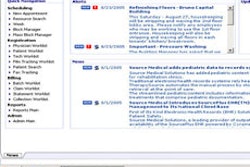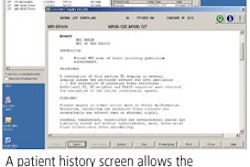Exhortations to "work smarter, not harder" or "do more with less" offer little comfort to anyone who's been saddled with a greater workload and no resource increase. Unfortunately for the overwhelming majority of radiologists, increasing workloads are business as usual as diagnostic imaging utilization grows rapidly year after year.
Radiologists have begun to take matters into their own hands, by designing and crafting applications that automate and prioritize the interpretation of patient cases based on clinical urgency.
Dr. Mark Halsted, chief of the informatics research core in the department of radiology at Cincinnati Children's Hospital Medical Center in Ohio, presented results from an in-house developed tool, RadStream, at the 2005 RSNA conference in Chicago.
"Most PACS' work lists, even if they sort by stat, don't give the radiologist information as to which stat is truly stat," Halsted said. "If you simply choose the next stat patient on the work list, you may miss a patient's case that is in greater need of interpretation."
The requested procedure priority tag in DICOM <0040, 1003> provides for the designation of low, routine, medium, high, and stat. Stat is used for a patient case that is life-threatening, in which action needs to be take immediately. It is also used for an emergent case, in which action needs to be taken within minutes to an hour.
Halsted observed that most PACS work lists are often based on time and date of case acquisition rather than on a patient's medical acuity. However, it is well established that a severely acutely ill patient should be seen before a mildly ill patient regardless of when each patient arrived in the department, he said. The facility generates approximately 180,000 cases annually, and is also responsible for readings from 10 satellite facilities.
Halsted's group developed, tested, and validated a new electronic triage ranking algorithm, and used it to develop an automated radiology triage system, RadStream, on a Web-based platform. Information for the application is received from the RIS and PACS with no demographic data duplication required, according to Halsted. He said that this keeps the records as accurate and updated as possible.
The only data manually keyed into RadStream is by the technologist, who enters comments about the exam, the medical acuity, and operational indices into the application. Once that information has been populated with patient information, radiologists can select and filter their work list on the basis of acuity and service for their area of expertise. A radiologist can also dynamically re-sort the RadStream work list to assist a colleague or another area of service to better manage workload.
"In order to prevent duplication of effort, radiologists can be assigned cases, either by themselves or by a technologist at any point after the case has been ordered," Halsted said.
After the case has been interpreted, dictated, and signed, RadStream forwards the information onto an operator, who is provided contact information for the patient's referring physician. This allows for the timely delivery of report information, particularly for emergent cases, without breaking the workflow rhythm or productivity of the interpreting radiologists. In addition, if the radiologist needs to speak to the referring physician, the RadStream report is marked as such, and the operator facilitates the contact for the radiologist.
"A permanent log is kept of all communications regarding cases, including the time, date, and persons involved in each communication event," Halsted said.
This log provides a useful audit tool in the event of a physician complaint, he said, because the department is able to specify who in a referring physician's practice received the group's interpretation results, and when they received them.
Since the implementation of the automated radiology triage system at the facility this past summer, Halsted reported that the department has been able to reduce its mean report time (reading, transcription, and sign-off) for the emergency department from almost eight hours to slightly over six hours. The mean in-patient report turnaround times decreased from seven-and-a-half hours to just over seven hours. Mean turnaround time for outpatient reports were trimmed down to five hours from a pre-RadStream implementation time of seven hours, according to Halsted.
"The impact of RadStream at our institution has resulted in faster report turnaround times, higher throughput, and the ability to balance our workload dynamically so we can cover our colleagues from any location, anywhere, at anytime," said Halsted. "In addition, the quality of our communications to our referring physicians has also greatly improved."
The group has established a Web site, RadStream.org, to provide more information about ongoing developments with the application.
By Jonathan S. Batchelor
AuntMinnie.com staff writer
December 16, 2005
Related Reading
Referral physician relationships drive imaging center success, November 25, 2005
Web-based workflow and reporting systems keep imaging on track, March 10, 2005
Web-based application nets teleradiology benefits, January 31, 2005
'Pleased to meet you' -- academic imaging center moves market with personal touch, December 2, 2004
'Safety net' system stops patients from falling into follow-up black hole, May 5, 2004
Copyright © 2005 AuntMinnie.com



















